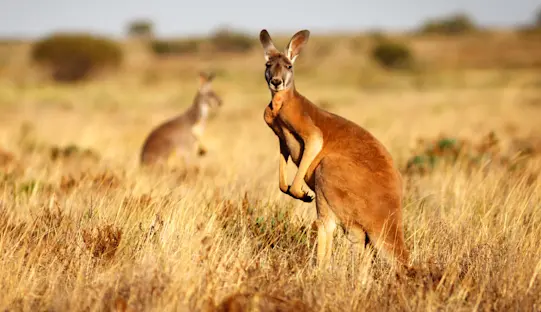
Playful coyotes will invite badgers to romp between hunting activities. ©Henry H. Holdsworth
For much of recorded human history, whenever coyotes and humans have come in contact, it is the coyotes that lose—big-time. But unlike many species that have succumbed to extinction under a similar scenario, somehow these wild canids have managed to survive and even thrive.
Ranchers and coyotes have always been at odds, since coyotes kill livestock worth millions of dollars every year. Many more millions have been spent on cyanide, strychnine, baited sheep collars and guns to destroy them. But whenever humans try to “control” coyotes, the coyotes respond by expanding their range and compensating for increased mortality by producing more pups. Today, coyotes reside almost everywhere in North America not permanently covered by ice.
Because coyotes have colonized every habitat from wild prairies to urban centers from coast to coast, they should be very familiar to us. In fact, a conservative estimate of the number of coyotes currently living in metropolitan Chicago is more than 2,000. Yet few people have seen them, and they remain elusive.

Badgers can dig as much as 10 feet down in a matter of seconds.
So, nothing should surprise us about the capabilities of this poorly understood animal. But something remarkable does: the unusual hunting partnerships they form—with badgers.
Better together
A 1992 study conducted at the University of California’s Department of Wildlife and Fisheries Biology confirmed that the two species work together to catch prey. In fact, it is far more likely to witness coyotes seeking out food alongside badgers than to see them hunting with other coyotes.
Both coyotes and badgers love to eat prairie dogs and ground squirrels. But because prairie dogs have a great neighborhood watch system, even the best hunters find them a challenge. Coyotes have no difficulty sniffing out prairie dogs; it’s digging them out that is the problem. Prairie dogs construct many escape tunnels, which befuddle the best predators. That’s why coyotes sometimes prefer prey that is slower and fatter—such as a badger.

A coyote goes mousing on the National Elk Refuge in Wyoming. ©Henry H. Holdsworth
But badgers also like catching prairie dogs and ground squirrels. And while they can dig faster than a man with a shovel—as much as 10 feet down in a matter of seconds—they can’t run as fast as a coyote.
Workmate and playmate
So, the two team up to combine their speed and digging abilities. Badgers can excavate prey that runs into burrows; and coyotes can chase down those that try to escape overland.
The coyote doesn’t eat the badger because hunting together is 30 percent more successful for the coyote than hunting alone. In Wyoming, in fact, scientists have seen badger-coyote teams working together for an hour or more. Because coyotes hunting with badgers eat more and have to work less than solitary coyotes in the same area, researchers have even seen them mock-chasing or otherwise playfully inviting lethargic badgers to a game between hunting activities. Badger-coyote teams are so effective that researchers often report seeing the same pairs working together again and again.

In many Native American myths, Coyote is a trickster. His antics—whether heroic, obscene or ridiculous—are intended to teach listeners about cultural and ethical norms. According to scientific research, teamwork should be one of them. ©Henry H. Holdsworth
Science is starting to show that Coyote’s reputation among many Native American cultures as the clever and smart Trickster is probably not so far from the truth. It seems that these wild dogs can run the numbers, weigh the odds and then adjust their behavior to take advantage of every sticky situation they find themselves in.
Only their solutions to problems seem to side with teamwork rather than attempts to eradicate another species from the face of the Earth.
Here’s to finding your true places and natural habitats,
Candy






























